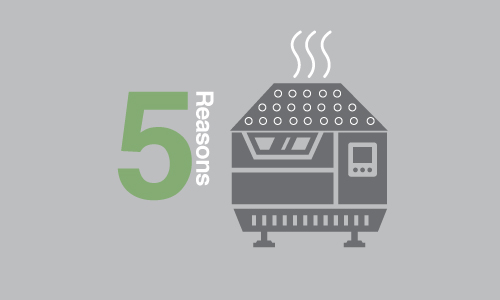Industrial ovens and dryers are among the most reliable pieces of equipment at a manufacturing facility. Often giving an organization a decade or more of reliable service, these pieces of equipment often live longer than employees stay at your company, so if you’re a production supervisor or manager, you may have to dig through the books to find when your current equipment was bought.
That said, even the most reliable pieces of equipment have a limited shelf life, and if you begin to see any of the following signs, it may be time to start looking at your options.
Inefficient to Run
One of the first things you’ll notice when your oven approaches the end of its life is the increase in costs to keep the oven operating. Over the 10-20 years that you will use an industrial oven, the insulation becomes less effective, doors leak in batch ovens, and more, resulting in lost heat. Lost heat is wasted energy, energy you pay to generate through fuel.
The older an oven gets, the worse the efficiency becomes; even if throughout a long life the oven has paid for itself, the operating costs inch up each month as you pump more and more fuel for diminishing returns. Comparably, modern ovens operate not only more efficiently than your current oven at present, but better than your current oven did in its prime.
Inconsistent
While downtime means that zero products are made, inconsistent ovens are on the other end of the spectrum. Your customers have come to expect consistency from your products, and any deviation from necessary temperature could cause early product failure, lower quality, or complete loss of a batch.
Whether it’s in the form of a hot or cold zone within the oven, an airflow issue, or an inconsistent temperature, a deviation of more than +/- 5°F could ruin your product and in turn, your customers’ perceptions of your ability to provide quality or on time shipments.
Unreliable
Even if it’s well maintained, the application of heat over the course of five, ten, or twenty years takes a toll on the many components that make up an industrial oven or dryer. Parts can be replaced, repairs can be made, and maintenance can be completed, but as we discussed in our article on conveyor systems, wear and tear adds up for any piece of machinery. Add heat to the equation and the wear and tear is accelerated.
Ultimately, the breakdowns become more frequent, costlier, and more debilitating to your bottom line. Every minute that goes into shutting down an oven, making the repairs, and getting the oven back to operating temperature is time that you are paying employees to do nothing. Worse, if the repairs can’t be made in-house, the downtime is longer and the costs higher while you wait for a service technician to arrive and make repairs.
Unsafe
Safety is concern number one for a manufacturer, and much like the breakdown of insulation could cause heat loss or inefficiency, damage to heating elements, exhaust vents, or gas delivery could easily pose a risk to the safety of your employees. As your oven ages, you may begin to see issues pop up during daily, monthly, semiannual or annual inspections that result in potentially hazardous situations.
As with downtime, this means you will have to shut down the operation, make repairs, and restart the entire system, but if these issues start to become more frequent, it may be time for a change. Modern industrial ovens take advantage of new technology that will simplify the inspection process, warning you of potential breakdowns or hazards before they take place and giving you the opportunity to make repairs during downtime.
Change in Production Schedule
Of course, it might not be your oven that’s an issue. Changes in production schedule are also some of the most common reasons that a manufacturer may need to replace an oven or dryer. If demand has increased, you likely need to operate your oven more hours each day, putting additional strain on the components and decreasing the life. Alternatively, if demand has dropped and you are using an oven or dryer too big for the job, you are wasting too much time and money on fuel and operation costs while you could downsize and put that oven to better use or sell it.
Learn More: Oven and Dryer Guide from The CMM Group
The industrial oven and dryer market may not feel like it has changed over the years, but it has. New technologies have made it easier to collect data, prepare for maintenance, and reduce costs, improved efficiency has driven down fuel costs, improved componentry results in better reliability, and customization has made it so that you can get exactly what you need for your operations as opposed to building your operations around an oven.
To help manufacturers better understand their path to purchase for an industrial oven or dryer, The CMM Group has released a detailed new guide to share more information about the industrial oven buying process. Five Steps to Selecting an Industrial Oven or Dryer for Your Manufacturing Facility shares more information about the warning signs while discussing the steps you need to take to get what you need from a custom machine manufacturer. We invite you to preview the guide below and download it in its entirety here.
Related Resources
- A Beginner’s Guide to Airflow Management for Industrial Dryers and Ovens
- 7 Tips on Getting a Custom-Built Industrial Dryer That Fits Your Needs
- What to Expect Throughout the Custom Equipment Consultation Process
- Everything You Need to Know About Industrial Drying Ovens
- The Many Applications for Industrial Ovens and Dryers




